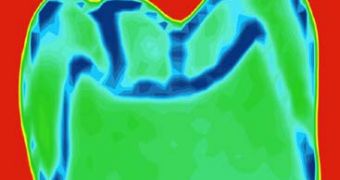New devices operating in the terahertz wavelength of the light spectrum could change the way security and medical detections are usually being made. Electromagnetic wave sent as terahertz frequencies, also known as T-ray operate in the 300 gigahertz to 3 terahertz domain close to the edge of the microwave spectrum, or the far infrared.
Since the early 1990s, scientists struggled to create devices that could produce electromagnetic wave at these frequencies. Though the terahertz wavelength is a non-ionizing type of radiation, meaning it is not harmful to biological entities, it has similar penetrating capabilities to the microwave radiation and can easily pass through non-conducting materials such as clothes, cardboard, wood and ceramics, but they are completely absorbed by metals and water.
Recently scientists have been able to produce a prototype of a device that could detect coherent T-ray radiation, that could prove valuable due to the fact that terahertz wavelength can offer a much better image resolution than the microwave radiation. The usual technique used to produce T-ray radiation, was by using laser of microwave generators, that could be forced to create terahertz radiation. But devices that could produce radiation somewhere in the middle of the T-ray wavelength, also known as the 'terahertz gap', that ranges between 0.5 and 2 terahertz, remained unreachable.
Physicist at the Argonne National Laboratory, including Ulrich Welp, have started to get closer to the creation of quantum devices that could create powerful beams, with the help of quantum devices that in the past were not able to produce the expected results.
The quantum device which is used is a Josephson junction that works on the basis of the Josephson effect. A basic Josephson junction represents an alternating structure of superconducting and insulating materials. The Josephson effect appears when a junction formed of a superconducting material where a thin insulating filling is inserted, creates a 'current tunnel' in the insulator material as voltage is applied to the supercondutor, thus generating terahertz wavelengths.
However the use of single junctions is extremely ineffective since they produce only low amounts or radiation, previous devices only being able to produce powers around a millionth of a millionth of a watt, or a picowatt. So researchers decided to use devices with multiple junctions that work in sync. Welp designed a prototype by using hundreds of such junctions working together that can produce a laser-like beam of radiation 10,0000 more powerful than a single junction, about half of microwatt.
Junctions produced this way are called BSCCO and are a type of high-temperature semiconductors, formed of hundreds of Josephson junctions, of superconducting materials only a few atoms thick, separated by gaps of insulating materials only 1.5 nanometer. To give you an idea how small the device is, a crystal 100 microns wide and 300 microns long can contain more than 600 individual junctions.
To get them synchronized in order to work together, a voltage of certain levels must be applied along the whole superconducting structure, to create stationary electromagnetic waves, analogue to the principle on which the laser works by reflecting electromagnetic wavelength to determine the gas used to emit synchronized photons.
The team was able to create T-ray radiation, in the gap between 0.36 to 0.85 terahertz which represents about a third of the so-called terahertz gap, by using several different sized crystals. The team's goal is now to further amplify the power of the current device.

 14 DAY TRIAL //
14 DAY TRIAL //